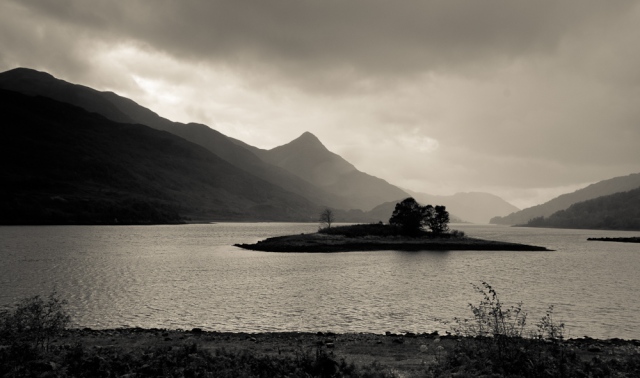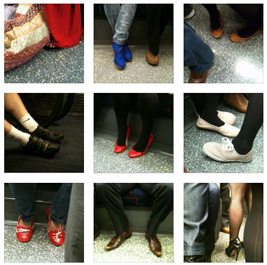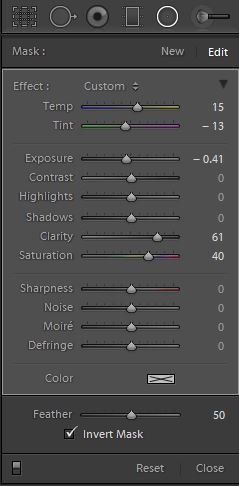
Driving out of Glencoe… © George Parapadakis
(Geek alert: There will be camera gear discussions here… )
So, it’s true… You pick yourself up, you dust yourself off and you move on.
After that incident, I went a bit cold on photography, in general. Even though most of the holiday shots were safe on my backup drive, I looked at them a few times and did not feel inspired to do much with them… A lull.
Two months later, things are slowly getting back to normal. Acquiring a new work laptop was sorted relatively easily, but restoring it to full working order from the backups, took a couple of weeks. In contrast to that, I bought a second hand iPhone and was grateful to Apple (I’d never thought I’d say that…) for their almost one-button restore process.
The cover for personal items on the travel insurance was laughable, not even worth filling the endless forms they were asking for, but the House Contents insurance gave me a neat cheque to start rebuilding. Not the full amount that I will need to replace everything, but certainly the full amount that the policy allowed for. And they did so with very little hassle. Thank you Nationwide!
So, with basic connectivity sorted out, first stop was buying a portable camera: I used to carry around a Casio Exilim SX10 with me all the time, which was tiny and has given me some excellent pictures, but I wanted something better with more manual control and something I can travel with. Whenever I’m on a business trip, I always try and spend some photography time if I can. That usually meant carrying my DSLR kit everywhere. This time I opted for a Lumix LX-5, which is portable enough to be permanently in my bag, but also serious enough to be able to do some decent photography while travelling. That’s the theory at least. At a price that is more expensive than an entry DSLR and almost three times the price of the Casio, it better be!!! 🙂
Then came the question of replacing the DSLR: Since I lost most of the lenses with the camera, I considered the option of changing system altogether, moving from Sony to Nikon. But I decided that I still have enough other accessories, flashes, adaptors, lenses, etc. that would be wasted if I didn’t get another Sony. And I’ve always been a Minolta fan, so there is an element of brand loyalty involved.
But, which one? My stolen one was a a350, which was a great camera, but it had serious limitations when it came to low-light photography. Newer Sony generations have a much better processor for reducing noise on high-ISO settings. They are still lagging behind Canon and Nikon in that respect, but at least speeds up to 6400 are now usable. I considered briefly the a390 which was a very small step up from the a350, and I really did not like the look and feel of it anyway. I knew that if I bought that I would be looking for upgrading it soon. So next in the list was the a580 or the new a55.
These cameras are basically offering the same features, apart from the fact that the a55 uses the new translucent mirror technology. I had a quick look at the a55 at Jessop’s and two things struck me: (1) the body is tiny. It looked like a hybrid/bridge camera and it didn’t sit well in my hand. I can imagine it with a bigger and heavier lens like the Sigma 17-70 or 10-20 on it, it will also be out of balance. (2) I found the electronic viewfinder experience quite odd and I wasn’t prepared to waste some of the low-light capabilities of the sensor, to the translucent mirror (at least a 1/3 of a stop). I also did not need the extra shooting speed that it offers (10 f/m). So I decided to go for the a580 instead which is a tad on the larger and heavier side (compared with the a350 that I was used to), but sits well in my hands.
In the meantime, I was also considering what to do about lenses. The four I lost were Sigmas (17-70, 10-20 and 105 micro) and an older Minolta 70-300. I looked hard at alternatives, but I decided that, without forking out grand amounts of money for Carl Zeiss lenses, the best quality and flexibility at an affordable price were exactly the lenses I lost. So I’ve ordered a new 10-20mm, I managed to find a second hand 105mm and I also ordered the new 17-70mm, which now comes with Optical Stabilisation built in. (I’ll write a separate blog on the a580 with the new 17-70). I’m still on the lookout for a good second-hand 70-300, although I still have my trusted Minolta 70-210 (beercan) to keep me going.
Next on the list was an infrared camera. In the past, I played around with IR filters on DSLRs, which are very limiting, and eventually bought a second-hand Minolta 5D which I converted to a proper full-time Infrared DSLR by removing the built in “hot filter” that completely cuts out IR, replacing it with a 720nm IR filter. The operation was successful and the end result was a great DSLR that would take all of my lenses and would shoot IR at normal camera speeds. It was great fun and I’m really sorry it’s gone.
So I started looking at ebay for a replacement one, planning to repeat the conversion exercise. However two things were bugging me: The IR conversion is not simple. It’s a complex, delicate and super-clean operation as it involved taking the camera completely apart, down to the unprotected sensor. It’s a project that you have to start and finish more or less in one go, you cannot do it in stages. Last time, it took me months to find the right, uninterrupted, time to start the project, with space to work and without kids and dogs running in and out. The other thing that was bugging me was bulk. Much as I enjoyed the fact that I could use all my lenses on it, carrying around a second DSLR body just for the odd occasion that an IR opportunity may come along, was rather annoying and heavy.
While browsing eBay I came across a couple of refurbished, IR converted compact cameras on sale in the US. The price tag was about the same as a second hand body plus an IR filter would have cost me, and all the hard work converting them (and testing them) had already been done. So I’ve decided to try one of them out (another Lumix, as it happens). The disadvantage of course is that I can’t use my normal lenses, but it has a decent zoom, and the advantage is that I can easily carry an IR camera around with me wherever I go. I’m still waiting for the camera to be delivered, so more impressions when I get hold of it.
So with that, with the odd polariser filter still missing, I’m more or less back where I was. I won’t be replacing my iPod (didn’t use it much) and I won’t be replacing my Zoom SLR Gorilla pod (I’ll buy a decent travelling tripod instead).
Last weekend, some of the kit got its first outing: A trip to Scotland – Even though the Lumix LX5 is a great little camera and has no problem taking decent pictures, it was a great relief to have a proper DSLR camera in my hands again. I know it sounds snobbish and geeky, and I know that the kit does not make the pictures, but it felt right in my hands and I got inspired again to do some proper photography again after a few months drought…


 I love this picture. I took this picture in 1979, wandering around the Greek flea market (Monastiraki). There is something about the composition that makes it one of my favourites.
I love this picture. I took this picture in 1979, wandering around the Greek flea market (Monastiraki). There is something about the composition that makes it one of my favourites.














































































































